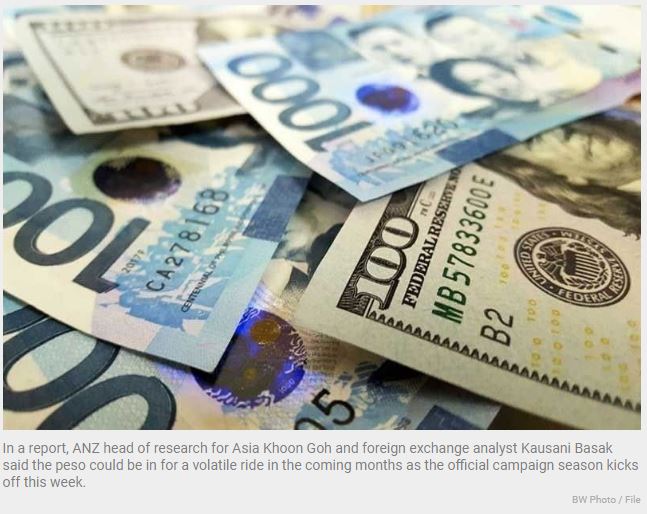ANZ sees Philippine peso depreciation this year
MANILA, Philippines — A repeat of the sharp depreciation of the peso in 2018 is possible this year, especially after the May 9 polls due to the tightening cycle of the US Federal Reserve and the country’s widening trade deficit, according to ANZ Research.
In a report, ANZ head of research for Asia Khoon Goh and foreign exchange analyst Kausani Basak said the peso could be in for a volatile ride in the coming months as the official campaign season kicks off this week.
“It is possible that we could see a brief rally in the peso before renewed weakness sets in as election draws closer. But any gains in the peso are likely to be modest given the challenging macroeconomic and financial market backdrop this year,” ANZ said.
ANZ said the Philippines’ trade deficit is at record level to start with, even after taking remittances from overseas Filipino workers (OFWs) into account.
As capital imports rise on the back of the increase in government infrastructure spending, on top of high oil prices, ANZ said the external deficit is set to widen further as this would be the first time that the presidential election is held in the midst of a US Fed tightening cycle.
“Our current yearend forecast for the peso is 52.50, which is weaker than consensus estimates. Given the mounting downside pressure from the large external deficit, we see further downside risk to our forecast. A repeat of the 2018 period when the peso depreciated toward 54.40 is a possibility,” it said.
The peso depreciated by 5.3 percent to close 2018 at 52.58 to $1 from 49.93 to $1 in 2017. During the year, the peso touched a low of 54.325 to $1 in September.
The local currency shed 6.2 percent to close 2021 at 50.999 to $1 from 48.023 to $1 in 2020.
The country’s trade deficit swelled by 75.4 percent to a record high $43.14 billion last year from $24.6 billion in 2020, as imports surged by 31 percent to $117.78 billion from $89.81 billion, faster than the 14.5 percent increase in exports to $74.64 billion from $65.21 billion.
ANZ said there was a strong run up in the peso during the initial stage of the campaign period during the elections held in 1998, 2004, 2010 and 2016.
During the 1998 elections that coincided with the Asian financial crisis, the peso plunged by more than 40 percent between July 1997 and January 1998 after initially strengthening during the first half of the campaign period.
In the 2004 elections, the peso weakened during the early part of the campaign period, but rallied strongly heading into election day.
For 2010 and 2106, ANZ said the peso rallied during the initial stage of the campaign period, an unwinding of gains heading into election day, a post-election bounce, followed by a deep decline in the subsequent months.
“There is a tendency for the peso to appreciate during the early part of the campaign period. However, there is a reversal in gains as election day draws near, and with further declines in the peso in subsequent months,” ANZ said.
During the four elections years, ANZ said the first half gross domestic product (GDP) growth averaged at a seasonally adjusted 6.1 percent compared to 4.9 percent for all other half year growth rates between 1993 and 2019.
“Philippine economic growth tends to be stronger during presidential election years,” it said.
ANZ said the main drivers for the stronger economic activity during election years are the ramp up in government infrastructure-related spending ahead of the ban on public works and higher government spending on election preparations, and campaign spending by candidates and political parties.
Source: https://www.philstar.com/business/2022/02/09/2159428/anz-sees-philippine-peso-depreciation-year


 Thailand
Thailand




